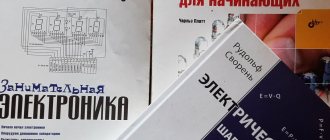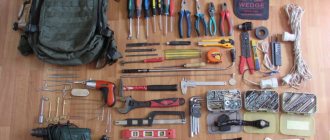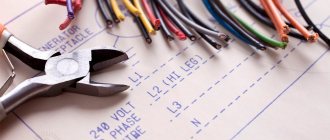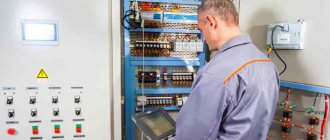Electricity is something without which it is impossible to imagine life in the modern world. Therefore, the profession of an electrician is in demand today. You can get it by graduating from college or taking a short course. And to become an electrical engineer, you will need to study at a university. And if you want to master electricity in everyday life and understand the basic terms and skills, a training course for a young electrician from Vladimir Kozin will help you with this.
Electrical laws and formulas are required not only for carrying out any calculations. They are also needed by those who practically perform operations related to electricity. Knowing the basics of electrical engineering, you can logically determine the cause of the malfunction and eliminate it very quickly.
Young electrician course
This young electrician course is mainly intended for novice electricians. In it we will look at connecting sockets, switches, and light bulbs. Let's figure out what electric current is and what voltage is. Using video examples, you will learn what an electrical circuit is and how it consists and works. Learn how an electrical circuit works with a switch, as well as with a two-button switch..
Vladimir Kozin
Summary of the course: the video course consists of 5 parts, each with 2 lessons. Young electrician course with a total duration of about 3 hours.
- In the first part you will be introduced to the basics of electrical engineering, consider the simplest diagrams for connecting light bulbs, switches, sockets and learn about the types of electrician's tools;
- In the second part you will be told about the types and purposes of materials for the work of an electrician: cables, wires, cords and you will assemble a simple electrical circuit;
- In the third part you will learn how to make switch connections and parallel connections in electrical circuits;
- In the fourth part you will see the assembly of an electrical circuit with a two-key switch and a model of the power supply of the room;
- In part five, you will look at a complete model of the electrical supply of a room with a switch and get tips on safety when working with electrical equipment.
Training course for a young electrician
The ultimate goal of training. This is to give you an understanding of what electricity is and how to work with it correctly. As a result of studying the course, you will learn what materials and cables to use during installation work, learn how to assemble a simple electrical circuit, a circuit with a socket or two-button switch, a circuit with a parallel connection of lighting fixtures with a switch. You can assemble the complete electrical circuit of the room yourself.
The main thing is to take a responsible approach to studying all the nuances - electricity does not forgive mistakes. Remember, your safety and the health of others should come first.
We invite you to familiarize yourself with other educational video lessons on electrical topics:
- DIY electrics in apartments and houses
- Electrical for your home
After completing the training, you will be able...
Choose cables and wires wisely
There are a lot of myths, misconceptions and frankly unnecessary scientific information piled up around the choice of cables (wires). We will present to your attention a practical (applied) classification of cable and wire products and explain the main criteria for selecting products to perform various tasks.
You will learn:
- select products with the optimal cross-section, taking into account the expected loads and various nuances of the operation of electrical installations;
- use single-core and stranded wires (cables, cords) based on technological feasibility;
- observe the color coding of the wires;
- give open wiring an aesthetic appearance.
Carefully and quickly cut cables and strip wires
Understanding the complexity of the situation with the skills of cutting cables and stripping wires, we have developed detailed step-by-step instructions with a large number of photo illustrations taken from all possible angles - so that everything is clear to everyone.
We will teach:
- cut cables NYM, VVG and its analogs, cords PVS, KG and ShVVP;
- strip single-core and stranded copper and aluminum wires;
- determine the optimal length of the shell to be removed depending on specific tasks;
- [attention, exclusive!] perform stripping in extreme conditions - after burning, melting or other damage to the insulation.
Properly restore damaged insulation
Damage to wire (cable) sheaths can pose a danger to people. Plus they look disgusting.
After completing our course, you will learn how to restore isolation:
- using various types of electrical tape;
- through the use of cambrics;
- through the use of heat-shrinkable tubes;
- [attention, exclusive!] due to the sheaths of solid wires;
- and also be smart when solving non-standard problems related to repairing the casings of cable and wire products.
At the appropriate lesson, we will explain in detail under what conditions one or another method is most preferable, and will also protect our students from a number of specific mistakes.
Make reliable connections
It would seem that connecting wires is the basis of the electrician’s profession, but it is in this component of the work that a huge number of mistakes are made, sooner or later leading to electrical accidents.
To avoid excesses, we will teach:
- safely connect copper and aluminum conductors (avoiding their direct contact);
- choose only high-quality terminal blocks (connectors);
- use connectors strictly for their intended purpose, based on real experience in their operation (without listening to the promises of cunning advertisers);
- several simple techniques that radically increase the reliability of contact;
- almost primitive, but very effective method of operational quality control of connections.
Work confidently with gypsum, using the full range of its unique properties
Gypsum (alabaster) is definitely the best binder for electrical installation work. However, in order to fully realize the potential of this material, you need to know and be able to do something.
You will learn:
- choose high-quality plaster so as not to suffer, but to do everything quickly and efficiently;
- work using the correct tools and equipment for gypsum solutions;
- [attention, exclusive!] correctly select the consistency of the solution to perform specific tasks in various conditions;
- [attention, exclusive!] avoid voids and chipping of plaster when installing mounting boxes;
- use gypsum extremely sparingly and reduce waste to a minimum.
And…
You will learn…
- about the long-term results of using common technologies and materials (something that ordinary electricians are not even aware of);
- about the typical mistakes of our colleagues, who step on the same rake over and over again;
- about the potential troubles caused to us by cable factories, and about methods for preventing accidents caused by undersized conductors;
- that not all terminal blocks are equally useful, and some are even dangerous;
- much more.
Receive a secret gift not available to mere mortals
A secret must remain a secret, so we cannot reveal the contents of the gift at this time. But believe me, we did everything possible to make you satisfied!
You will be trained
Leonid Burmistrov
Third generation electrician, leading course instructor
Alexander Zaitsev
Expert practitioner, author of the guide “A Well-Fed Electrician”
Team of curators
Strict but fair and very attentive people
UNIQUE FUNDAMENTAL ONLINE COURSE
Basics of Electrical Engineering
In the first video lesson “young electrician course”, you will be told who the young electrician course is intended for. In it we will look at connecting sockets, switches, and light bulbs. Learn what electric current is and what voltage is.
Any electrical circuit contains a source of electrical energy and a receiver of electrical energy. Consider a simple electrical circuit consisting of a battery and an incandescent light bulb. The battery is the source of electrical energy, and the light bulb is the receiver.
Learn Ohm's law for a simple circuit. Voltage, resistance of an electrical circuit and passing electric current are related to each other by Ohm's law. It’s easier to remember these dependencies using Ohm’s triangle.
Typically these circuits are described by Kirchhoff's laws. When connecting conductors in parallel, the power source voltage is applied to both conductors. And with a serial connection, the receivers are connected one after another.
Conductors can be connected both in parallel and in series. Series connection of conductors. The total resistance of series-connected conductors. An example of a series connection of conductors. New Year's garland.
The role of Ohm's Law and Kirchhoff's Law in the life of an electrician. Why does an electrician need a head? Consequences of ill-considered actions.
Corrections version of the first lesson.
This lesson corrects Vladimir Kozin's slips using splash screens.
Main characteristics of current
The main characteristics include current, voltage, resistance and power. The parameters of the electric current flowing through the wire are characterized by these values.
Current strength
The parameter means the amount of charge passing through the wire in a certain time. Current strength is measured in amperes.
Voltage
This is nothing more than the potential difference between two points of a conductor. The value is measured in volts. One volt is the potential difference at which to transfer a charge of 1 coulomb it will be necessary to perform work equal to one joule.
Resistance
This parameter is measured in ohms. Its value determines the resistance to energy flow. The greater the mass and cross-sectional area of the conductor, the greater the resistance. It also depends on the material and length of the wire. If the potential difference at the ends of the conductor is 1 Volt and the current is 1 Ampere, the resistance of the conductor is 1 Ohm.
Power
A physical quantity expresses the speed of flow of electricity in a conductor. Current power is determined by the product of current and voltage. The unit of power is watt.
Ohm's law
The current strength in a section of an electrical circuit is directly proportional to the voltage at the ends of the section and inversely proportional to its resistance
Definition of Ohm's law in simple words
An electrical circuit consists of a two-pole voltage source, that is, a battery, accumulator or generator. If the poles of the source are connected with wires, then an electric current will flow through them. Its value is determined by the resistance of the conductors.
A visual representation of this dependence is an ordinary plumbing system. An analogue of a voltage source is a pump or water tower that creates pressure in the main, the amount of water passing through the pipe is a kind of current, and the tap corresponds to the resistance. Fully open, it does not restrict the flow; as it is twisted, the water hole decreases until it closes completely.
Legend
As in other areas, in electrical engineering there are generally accepted conventions, the main ones of which we will now get acquainted with - they will be useful for further work with electrical devices and networks. Below will be given the symbols and explanations for them, starting with the simplest ones, gradually moving to more complex ones.
Fig.1 Designation of a simple intersection of conductors
Fig.2 Designation of connection with crossing conductors
Figures 1 and 2 show outwardly similar, but fundamentally different symbols. However, schematic images of electrical and often radio elements are usually intuitive. So it’s not difficult to guess that Figure 1 shows a simple intersection of conductors, and Figure 2 shows their connection.
Fig.3 Switch designation
Fig.4 Designation – fuse
Also intuitive are Figures 3 and 4, which show a switch (Figure 3) and a fuse (Figure 4). It’s worth staying a little longer on the fuse - it’s an inconspicuous, but quite necessary detail, which often allows you to avoid serious troubles. The purpose of the fuse, as the name suggests, is to protect wiring and equipment from damage and fire. The fuse consists of a dielectric (non-current-permeable) tube and a conductor inside it. This conductor is designed for a current strength that is slightly less than the circuit it is designed to protect can withstand, and in cases of a voltage surge to a dangerous level, the fuse simply melts, thereby opening the circuit and protecting devices or wires from serious damage or ignition.
The following designations may not be so clear, but. I think many people I know from my school physics course.
RSI.5 Designation – light bulb
This is an incandescent lamp, also known as a regular electric light bulb (Figure 5).
Fig.6 Designation - resistance
Fig.7 Designation - LED
Fig.8 Designation – semiconductor diode
A resistor (in everyday life - resistance, Fig. 6), here, perhaps, we will add an LED, which is increasingly replacing ordinary light bulbs (Figure 7), as well as the element that gave the name to the LED - a semiconductor diode (Figure 8). I’ll tell you more about the LED - it got its name due to the properties of a semiconductor diode - passing current only in one direction - from the anode to the cathode (we are now talking about direct current). That is, when the positive pole of the power source is connected to the anode, current will pass through the diode, but when the negative pole is connected, the current does not pass and the circuit remains open. This property of the diode is shown in more detail in Figure 9 below.
Fig. 9 Designations of diode properties
No less important elements of electrical circuits are power connectors. Here is the simplest option - a socket (Figure 10) and a plug (Figure 11).
Fig. 10 Designation – socket
Fig. 11 Designation - plug
Now, knowing the schematic images of some basic elements, you can try to learn how to read and draw diagrams.
Electrician's tool
In the second video lesson “young electrician course”, you will learn what electrician tools you will need. An electrician's kit may consist of several tools. These are pliers (pliers), a mounting knife, a set of screwdrivers, round nose pliers and a measuring device. All tools must have insulated handles.
All instruments
You can find a knife with a triangular blade on sale. Instead of a set, you can use a universal screwdriver. Pliers are used to cut and twist wires. Using round-nose pliers, the wires are terminated in the form of a ring. A measuring screwdriver can be used as a measuring device to determine the phase.
What do electrician's tools look like? Minimum set.
For other measurements, a multimeter is used. It can measure voltage, resistance and current. You can also test the wires with a multimeter. The main thing is to check all devices before use.
Variable and constant quantities
When electricity was just in its infancy, consumers were supplied with direct current. However, it turned out that the standard value of 220 volts is almost impossible to transmit over a long distance.
On the other hand, you cannot supply thousands of volts - firstly, it is dangerous, and secondly, it is difficult and expensive to manufacture devices operating at such a high voltage. As a result, it was decided to convert the voltage - 10 volts reaches the city, and 220 volts reaches the houses. The conversion takes place using a transformer .
As for the voltage frequency, it is 50 Hertz. This means that the voltage changes its state 50 times per minute. It starts from zero and rises to 310 volts, then drops to zero, then to -310 volts and rises to zero again. All work proceeds in a cyclical manner. In such cases, the voltage in the network is 220 volts - why not 310 will be discussed later. Abroad there are different parameters - 220, 127 and 110 volts, and the frequency can be 60 hertz.
Electrical cables
In the third video lesson “young electrician course”, you will learn what electrical cables and flexible cords are needed for electrical installation. Construction of electrical wires and cables. Which wires are used only for external work and for internal electrical installations.
Selection of wire (cable) cross-section based on power
Example.
Let's take a one-room apartment. What electrical appliances do we use? Below you will see a table showing electrical appliances and tools used in everyday life:
| Household electrical appliance | Power, W | Household electrical appliance | Power, W |
| Bulb | 15 – 250 | Oven | 1000 – 3000 |
| Inkjet printer | 30 – 50 | microwave | 1500 – 3000 |
| Scales | 40 – 300 | Vacuum cleaner | 400 – 2000 |
| Audio system | 50 – 250 | Meat grinder | 1500 – 2200 |
| Computer | 300 – 800 | Toaster | 500 – 1500 |
| Laser printer | 200 – 500 | Grill | 1200 – 2000 |
| Copy machine | 300 – 1000 | Coffee grinder | 500 – 1500 |
| TV | 100 – 400 | Coffee maker | 500 – 1500 |
| Fridge | 150 – 2000 | Dishwasher | 1000 – 2000 |
| Washing machine | 1000 – 3000 | Iron | 1000 – 2000 |
| Electric kettle | 1000 –2000 | Heater | 500 – 3000 |
| Electric stove | 1000 – 6000 | Air conditioner | 1000 – 3000 |
Tips for beginners
Many physics books contain complex electrical diagrams and a variety of confusing terms. In order for beginners to understand all the intricacies of this section of physics, a special manual “Electricity for Dummies” was developed. An excursion into the world of the electron must begin with a consideration of theoretical laws and concepts. Illustrative examples and historical facts used in the book “Electricity for Dummies” will help novice electricians acquire knowledge. To check your progress, you can use assignments, tests, and exercises related to electricity.
If you understand that you do not have enough theoretical knowledge to independently cope with connecting electrical wiring, refer to reference books for “dummies”.
Switch connection
In the fifth video lesson “young electrician course”, you will learn how to correctly connect switches. How does the circuit breaker connection diagram work, what is the difference between phase and zero. And also how to determine the phase wire if the house has a three-wire power supply.
Usually, to disassemble the switch, you need to remove its key. There are screws under the key that need to be removed. We gain access to the switch terminals where the wires are connected.
Sometimes special latches are used to secure the switch body. In this case, they must be squeezed out carefully so as not to break. To connect the switch, cut one of the wires that goes from the electrical box to the light bulb. According to the regulations, you need to cut the phase wire.
Light switch
A switch is a device with which you can turn on and off the lights in the house. It is often not noticed, and therefore its significance is not fully appreciated. In fact, switches perform an important function: they provide power to electrical appliances.
During renovations, when installing a lighting system, many people, due to ignorance of the variety of switches, buy ordinary single-key models. At the same time, they may not suit the interior or may not withstand stress at all. That is why before purchasing it is important to understand how to choose lighting switches.
BASIC SKILLS FOR ELECTRICIAN
ONLINE ADVANCED PROFESSIONAL COURSE
Hello, dear colleague!
How are you doing? Are you doing well at work? Do you have enough money? Is your work respected in society?
In response to these pressing questions, of course, you can laugh it off - they say, there is never too much money, all customers are assholes, and society has no time for the work of an electrician, it is looking for spiritual bonds...
However, streamlined answers do not lead to solutions to objectively existing problems.
If you dig deeper, you will certainly find that we create most of the difficulties for ourselves.
Not wanting to realize and accept responsibility for our own lives and professional activities, many of us are not particularly eager to develop, improve our skills, or improve our qualifications. Not everyone had the opportunity to study systematically - the bulk of today's specialists came to electrical engineering by accident, “by the will of the waves,” and the quality of traditional technical education has dropped sharply in recent years.
It is impossible to build a large and beautiful house on a flimsy foundation! The lack of confident basic skills greatly hinders the professional growth of an electrician and provokes a number of negative phenomena.
- Toxic relationship
Nobody respects insecure professionals with trembling hands and fidgety movements.
This is how toxic relationships with customers/employers and a low income ceiling are formed.
- Waste of time
A weak level of proficiency in basic electrician skills leads to unnecessary waste of time.
The work takes an unacceptably long time to complete and often has to be redone under warranty.
- Extreme poverty
The chronic lack of decent earnings gives rise to a lot of everyday problems and threatens debt traps.
It is easy to fall off the social ladder, but it is incredibly difficult to climb it.
- Stagnation in everything
The meager wages (services) of an electrician lead to a shortage of resources for development. Long-term stagnation pushes you into a vicious circle: no strong skills, no money, and nothing to learn.
The problem described above is widespread. Our professional community is inert, and its participants are realizing the need for change very slowly. For now, things are still going strong, and weak performers contribute to the formation of negative ideas in society about the activities of an electrician. The facts speak for themselves...
How to connect a double switch
In the seventh video lesson “young electrician course”, you will learn how to correctly connect a two-key switch to two light bulbs. Double switches usually have 3 connection terminals. The phase is brought to a common mark.
The output load is connected to the other two marks. Other wires from the loads are connected to the neutral wire of the voltage source. Chandeliers are connected to apartments using the following electrical circuit.
It is not always possible to replace two single switches with one double switch. They can be connected in different ways.
For example, one can interrupt a phase, and the other zero. In this case, you need to change the wiring diagram, or use a double switch that does not have a common contact and has 4 pins. If there is a jumper between the two inputs, remove it.
PromProfAlliance (VAO)
Address : metro station Shchelkovskaya, Shchelkovskoe highway no. 100 building 1 office 3004 Website : https://docsro.ru Telephone Cost : from 3700 rub. per course
The center offers students electrician courses followed by obtaining a standard certificate.
What the courses will teach:
- Theory and practice of working with electrical appliances and the electrical network.
- Fundamentals of electromechanics, electrical communications.
- Study of electric generators, transformers, electric motors.
- Design of wiring diagrams in an apartment, house, or on a site.
- Collection/repair of electrical networks of varying complexity.
- Cable installation, connection to the general network.
Training is carried out on the basis of vocational and secondary education. Programs are also taken to obtain a higher rank or change specialization. Distance classes are possible.
Power supply diagram
In the ninth video lesson “young electrician course”, we will look at the complete power supply diagram of the room. In addition to the diagram from the last lesson, we will need 2 circuit breakers rated 16A and a piece of insulated wire.
One circuit breaker will protect the light line and the other will protect the outlet line. Our electrical circuit has become secure. In the event of a short circuit or line overload, the circuit breaker will disconnect the faulty circuit. This also prevents fire.
What does it take to become an electrician?
To become an electrician, you first need to determine the direction you are interested in and the relevant features of the work.
In each of them there is a certain gradation according to:
- professions (electrician, electrician, electrician, engineer, etc.);
- qualification categories or categories on which the electrician’s salary and the list of works acceptable for performance in terms of technical and technological complexity and responsibility directly depend;
- clearance level - determines the compliance of the employee’s knowledge and skills in terms of labor protection and electrical safety, which are necessarily taken into account when servicing devices and determine the possibility of performing certain categories of work.
To become a professional electrician, you need to obtain an appropriate level of knowledge in this profession, which is confirmed by some document. After this, training takes place on electrical safety issues and technical operating rules to assign a qualification approval group.
electrical safety
In the tenth video lesson “young electrician course”, you will learn how all metal parts of electrical installations, which are not normally energized, must be grounded.
This grounding is called protective grounding. Serves to protect operating personnel from electric shock. In electrical installations, the housings of electrical machines, as well as metal structures associated with the installation of electrical equipment, are grounded.
The degree of electric shock depends on the strength of the current itself and the time it takes to pass through the human body. The strength of the current depends on the voltage in the circuit and the resistance of the body itself. According to Ohm's law. The resistance of the body depends on the state of the person at the moment. A voltage of no more than 50 volts is considered safe.
College of Science and Technology (CAO)
Address : metro station Smolenskaya, Novinsky Boulevard, 8 Website : https://www.collegent.ru Phone Cost : 12900 rub. per course
The College of Science and Technology has all the conditions for successful study:
- classrooms with modern equipment;
- practicing teachers with extensive professional and pedagogical experience;
- Individually focused practical classes in small groups of up to 6 people.
Upon completion of their studies, graduates are awarded a standard certificate, and the college provides assistance in finding employment.
Duration of training is 1 month.










